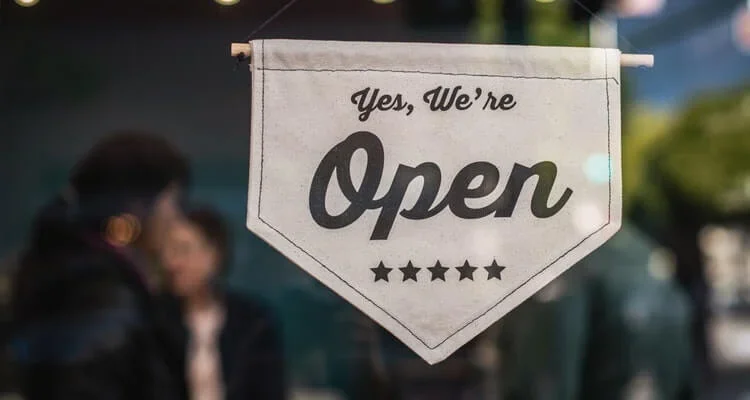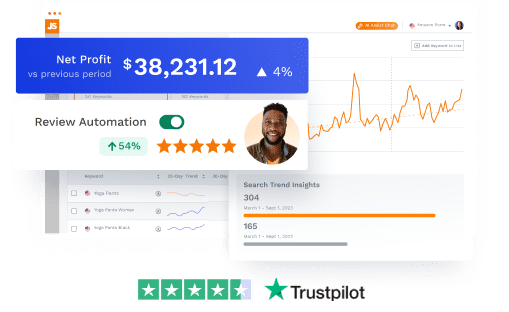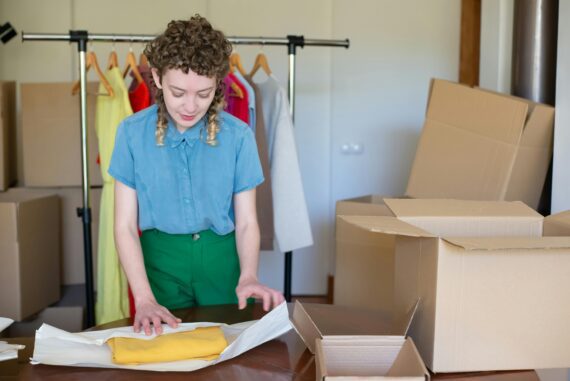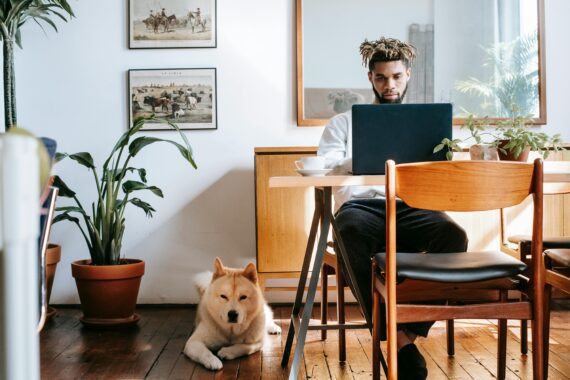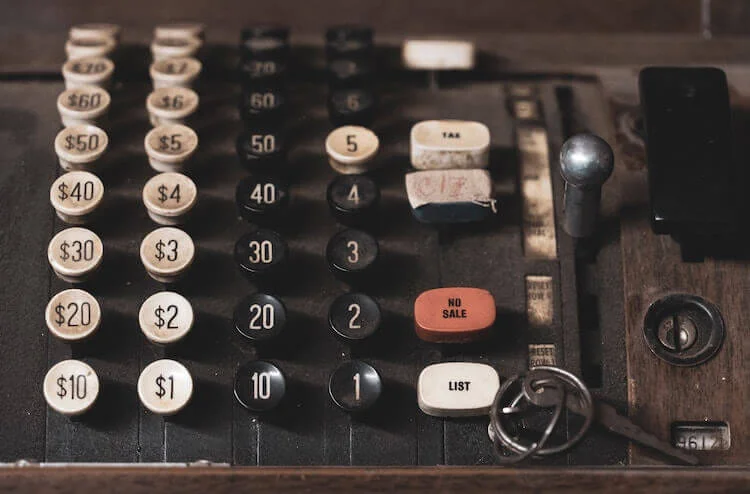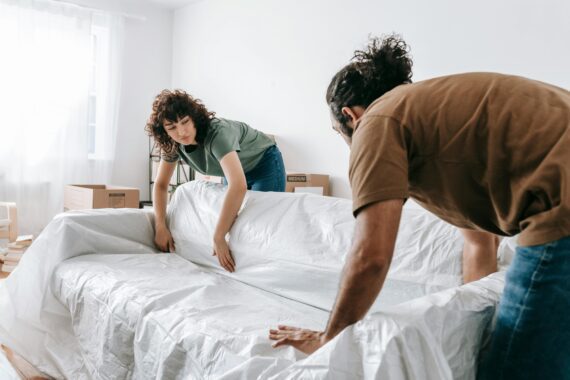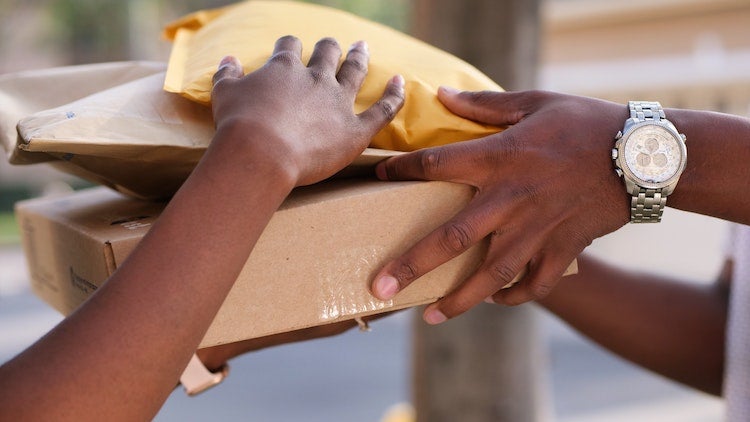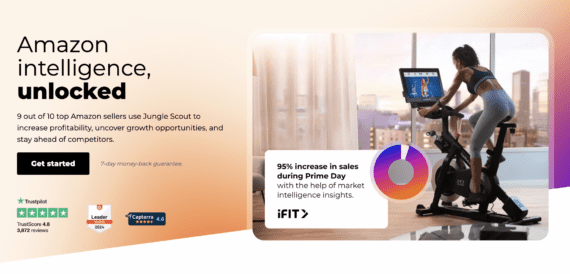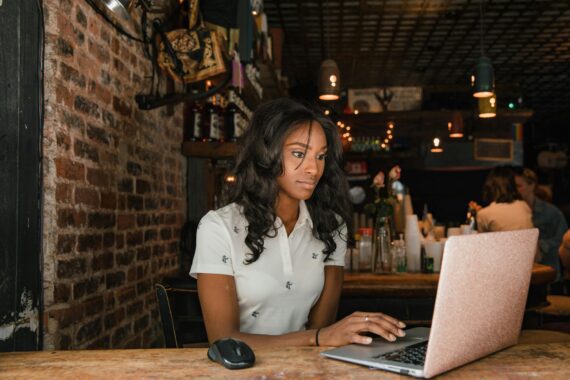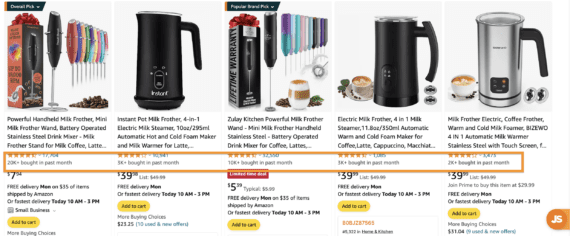Table of Contents
How much does it cost to start selling on Amazon?
How much money do you need to start selling on Amazon?
Required costs to start selling on Amazon
Recommended costs to sell on Amazon
Extra costs to sell on Amazon
How can you reduce the cost of selling on Amazon?
Things we recommend you don’t spend money on
Content
expand_moreTable of Contents
How much does it cost to start selling on Amazon?
How much money do you need to start selling on Amazon?
Required costs to start selling on Amazon
Recommended costs to sell on Amazon
Extra costs to sell on Amazon
How can you reduce the cost of selling on Amazon?
Things we recommend you don’t spend money on
Interested in selling on Amazon but worried about how much it will cost you? Good news! It’s not as much as you might think.
Based on Jungle Scout’s research, the majority of new sellers spend approximately $2,500-$5,000 to start selling on Amazon — including product costs, Amazon fees, and other necessary initial investments.
However, many Amazon sellers get started with $500 or less, while others pour five figures or more into new business — both extremes capable of finding success on Amazon.
We’ll cover the essential costs of selling on Amazon, and explore how different investments could result in different profits for Amazon sellers.
2024 Update:
In order to provide ecommerce entrepreneurs with all the information they need to succeed with their Amazon ventures—from launch, to first sale, to growth and scaling—we’ve updated our content for 2024. Looking for more information on starting an ecommerce business? Check out our updated guides for How to Sell on Amazon, How to Sell on Walmart.com, and How to Sell on eBay.
How much does it cost to start selling on Amazon?
Jungle Scout — the all-in-one platform for selling on Amazon — surveyed thousands of Amazon sellers to find out exactly how much money they spent when they got started on Amazon.
- 14% of Amazon sellers started with $500 or less
- 9% of Amazon sellers started with $501 – $1,000
- 16% of Amazon sellers started with $1,001 – $2,500
- 23% of Amazon sellers started with $2,501 – $5,000
- 18% of Amazon sellers started with $5,001-$10,000
- 17% of Amazon sellers started with more than $10,000
Do sellers who spend more find success on Amazon?
Spending more money to start an Amazon business does not always mean more success for the seller. In fact, sellers who started with less money tended to find success faster and have lasted longer than those who started with more money.
Cost of starting an Amazon business
Sellers who started with $500 or less:
- 22% have sold for five years or longer.
- 47% got their Amazon business up and running in less than a month
- 66% turned a profit in less than six months, and 42% turned a profit in fewer than three months.
- 30% list more than 100 products on Amazon.
- 57% spend fewer than 20 hours per week on their business, and 30% say they spend less than four hours per week.
Sellers who started with $10,000 or more:
- 23% have sold for five years or longer.
- 73% took longer than six weeks to get their Amazon business up and running.
- 32% turned a profit in less than a month, while 43% said it took them six months to two years to turn a profit.
- 20% list more than 250 products on Amazon.
- 70% spend more than 20 hours per week on their business, and 10% say they spend 60 hours or more per week.
How much money do you need to start selling on Amazon?
The remainder of this article breaks down the costs to sell on Amazon into the following three categories:
- Required costs: These are the required fees and other essential expenses you must pay to start selling on Amazon.
- Recommended costs: You can start a successful Amazon business without these line items, but it’s recommended that you make these investments.
- Extra costs: These are the costs that can help boost your business early on, but are unnecessary for someone just starting out.
First, how do you sell on Amazon?
The majority of Amazon sellers opt to manufacture and brand their own products to sell on Amazon — a business model called private label.
Here’s how this method works in four steps:
- Research. Use Amazon data to find a product with high demand and low competition.
- Source. Find a supplier that manufactures similar products to create your own branded version of the item.
- Launch. List the product on Amazon, choose a fulfillment method, Fulfillment by Amazon (FBA), or Fulfilled by Merchant (FBM), to ship your products.
- Advertise. Use Amazon’s advertising system, Amazon PPC, to promote and advertise your products on and off Amazon.
If you want to dive deeper into selling on Amazon, check out our How to Sell on Amazon for Beginners guide. It teaches you everything you need to know!
Required costs to start selling on Amazon
Before we break down the start-up costs for an Amazon business, we want to establish the type and quantity of products we’re planning to offer for our initial investment.
- We will sell on the Amazon U.S. store. (And we are based in the U.S.)
- We will sell our product as a private label product, using the FBA model, as it allows for greater scalability in the future.
- The total landed cost of our item is $4. (Your landed cost is the cost to manufacture the product plus per unit shipping costs, taxes, etc.)
- We will aim for a 100% Return on Investment.
- The product will be standard size (fits in a shoebox) and will be light enough to ship by air.
- We will purchase 500 units to sell.
Samples: ~$100 each
When sourcing a private label product to sell using Amazon FBA, samples are imperative.
As there can sometimes be a significant difference in the quality of the product and the specifications you see on Alibaba or other manufacturing sources online, the best way to verify quality and move forward with the best supplier is to order samples.
Once you find potential suppliers, we recommend getting a sample from the top three to keep costs low. (You will pay for the cost to manufacture the product plus the shipping cost.)
A rule of thumb here is that each sample will cost you $100 – could be less, could be more; it depends on the type of product. That’s from the supplier to your doorstep in five days or less. If you order the recommended three samples, expect a cost of around $300.
Once you receive the samples, you choose the sample that best fits your vision for the product.
Note: Sometimes a supplier will reimburse you for the cost of the sample, or credit it to your first order, if you decide to place and order with them;. It’s worth asking potential suppliers about this beforehand.
Inventory: approx. $2,000
Once you choose your supplier, you’re ready to purchase your product!
Suppliers you find on Jungle Scout’s Supplier Database, or on Alibaba, will generally have a Minimum Order Quantity (MOQ). In our experience, MOQs tend to be 500 units. So, for the purpose of our estimates, we’ll consider the cost of purchasing 500 units. (You can order a lower quantity if you’re able to negotiate this with a supplier, but generally, that means they will charge you more per item; in other words, it may not be worth it.)
We are also assuming our product will cost $4 per unit, including the product cost and shipping. At $4 per unit times 500 units, our expected initial inventory will amount to $2,000.
Note: If the thought of purchasing a large order of products is intimidating, consider dropshipping as your first step into the world of selling on Amazon.
Amazon Professional Sellers Account: $39.99/month
Whatever you choose to sell, you’ll have to pay Amazon for the ability to list products on its site. You can do this with either an Individual Seller Account or a Professional Seller Account.
The Individual Account costs you $0.99 per item sold, and the Professional Sellers Account is $39.99 per month.
Let’s plan and hope to sell more than 40 units per month, in which case a Professional Account makes more economic sense.
UPC code: $30
In order to start selling your product on Amazon, you will need a recognized barcode in order to generate an ‘FNSKU’ (Fulfillment Network Stock Keeping Unit), which is Amazon’s proprietary barcode that must be printed on the packaging of all of your products.
And to get your FNSKU, Amazon’s TOS requires you to get a GTIN (Global Trade Identification Number), usually in the form of a UPC code.
In 2018, Amazon changed its TOS to state that your barcodes must be from GS1, the leading global provider. GS1 now offers a single GTIN/barcode for just $30.
Total ‘required’ costs to sell on Amazon: $2,570
Recommended costs to sell on Amazon
The following are expenses we recommend adding to your budget to help set your Amazon business up for success.
Sponsored ads budget: $300 ($10/day for 30 days)
To help with a successful product launch on Amazon, you will need to use Amazon PPC ads to generate your first initial sales. Since the product will be brand new, customers will not be able to find your product as it will likely be on one of the last pages of the search results.
Promoting your product using Amazon Advertising, will help bring your product to the first page within the search results.
This strategy can quickly improve your sales.
Let’s assume you’re running ad campaigns with a lower-end budget of $10 per day. (This is the default amount Amazon suggests.) You can expect roughly 20-30 clicks on your product each day, resulting in 2-3 sales – assuming a 10% conversion rate. While this isn’t a one-size-fits-all stat, using PPC will help increase impressions and clicks to your product listing.
A very important step before running ads is to ensure your listing is fully optimized. If you have poor product images or missing information, your ads will not convert into sales – causing you to lose money.
Here are some excellent resources on setting up and managing your Amazon PPC campaigns:
- Amazon PPC Strategies: The Ultimate Guide
- Amazon Advertising Guide for Sellers
- The Ultimate Guide to Amazon PPC | Creating & Optimizing Sponsored Product Ads (2023)
Registered trademark: $350
If brand owners want to enroll their brand into the Amazon Brand Registry, you must have a registered trademark. (Note: You do not need a trademark to sell on Amazon.)
The Brand Registry is a program offered by Amazon where sellers can register as the trademark-holding owner of a brand. It helps Amazon identify your product as “official” and awards you additional benefits and selling privileges such as A+ Content, Amazon Stores, and advanced advertising products like Sponsored Brands Ads and Sponsored Display Ads.
However, sellers need to apply for a trademark and wait for it to be approved before being able to access additional features of Brand Registry. And the trademark process can take several months.
In today’s competitive marketplace, other sellers in your niche are likely Brand Registered, taking advantage of the many advanced features. Therefore, your best bet is to invest early and get the trademark process underway. That way, you can get your brand registered as soon as possible.
Just make sure you do your research when creating your brand to ensure you can apply for a Trademark without infringing on any existing trademarks or brand names in the future.
How much does a trademark cost? If you do it through a local IP attorney, it costs roughly $350. You can even apply for a registered trademark yourself through USPTO.gov – for about half the cost of going through an attorney or trademark service.
Note: If you wish to have your trademark registered faster, Amazon recently started an IP Accelerator Program. This program puts you in touch with Amazon-selected intellectual property attorneys and automatically approves your registered brand while you’re waiting for your trademark to be approved by the U.S. patent office. This option does cost a little more though — typically between $750 to $1,000.
Total ‘recommended’ costs to sell on Amazon: around $650 (plus required costs)
Extra costs to sell on Amazon
The following are costs you do not need to incur in order to start selling on Amazon. But, investing in these areas could help you present a more polished product and launch with a quicker path to success!
Design work: $200
A graphic designer is a tremendous asset in adding legitimacy to your brand. They can help you with logos, packaging design, product inserts, photography touch-ups, and infographics for your product listing.
And though it’s difficult to put a price on good design, a nice packaging design gives a product a high-end feel and makes it suitable for a higher price point.
For an early product launch, you can find decent rates from talented designers on freelancer hubs like Upwork and Fiverr.
Product photography: $300
When you are competing against other sellers who may have similar products, it is so critical to have your product stand out from the crowd. Great photos help you achieve this.
So, while we are putting photography in the “extra” section, if you’re going to go with just one extra expense, choose this one!
Here are the key attributes to get right:
- The best lighting possible
- A white background for the main image
- At least 1000 pixels wide on the longest side of the image in order to meet Amazon’s minimum requirements
- Some photos of the product being used (i.e. lifestyle shots)
- Think about conveying the size or quality of an item with closeups and comparisons
If you think you need professional help for this, you can get high-quality product photographs starting from $25-$50 per image. If we assume you need eight images and use the power of negotiation, we can cost this expense at $300.
Total ‘extra’ costs to sell on Amazon: $500 (plus required costs)
How can you reduce the cost of selling on Amazon?
If these costs seem high, we’ve come up with a few ways to lower your Amazon selling costs.
1. Consider a different business model
You can use a different model than private label.
For example, you can sell used books on Amazon or other items around your house, create your own handmade items, or do retail or online arbitrage. (Arbitrage is when you purchase a product from one place — such as a retail store or another online marketplace — to sell on Amazon.)
Many sellers found early success using these business models and eventually switched over to the private label model.
2. Purchase less inventory — or none at all
You can reduce your startup cost to sell on Amazon significantly if you source your product on Aliexpress instead of Alibaba, since Aliexpress will allow you to order smaller quantities and test the waters before investing in a bulk order.
The downside to this, though, is that you are paying a higher per-unit cost. It also means you are less likely to get customizations and specifications.
If you can, we advise using Jungle Scout’s Supplier Database or Alibaba and spending a little more on your inventory. After all, you are building your own private label brand and it’s important to get this part right.
3. Find a product with a low cost-per-item
In our example, we chose a product that is $4 fully landed, and we chose to purchase 500 to start.
There are legitimate, high-potential products you can purchase on Alibaba for $0.50. So, assuming a $0.25 shipping fee per unit, you could cut your starting inventory costs to $325 (500 units multiplied by $0.75).
Add in the samples ($300, as mentioned above), and the Amazon sellers fee ($40), , and you are looking at a $665 investment upfront.
This is about one-fifth the average cost to start a private label Amazon business.
4. Do it yourself!
Another key variable is time. If you’re strapped for time and resources and are unable to perform tasks like product research, design, photography and product listing setup yourself, then it will cost more to get started.
Ideally, do as much of the pre-launch work yourself as you can, particularly if you’re a new seller — or even if you’re an existing seller launching a new product.
When the product has launched and is flying off the shelves, that’s the time to start outsourcing.
Things we recommend you don’t spend money on
While there is no shortage of ways to invest in your Amazon business, some costs are more necessary than others. In general, we don’t recommend spending money on:
Legal Fees
You do not need to incorporate a business in order to sell on Amazon. Although many successful Amazon sellers opt to establish legal structure for their business (like an LLC), they do this further down the road in their Amazon selling journey, when it becomes necessary and financially viable.
Your own website
A standalone site may be useful in the future, especially if your brand expands beyond one or two products. However, it’s an unnecessary distraction in the beginning, as running your own website takes time, money and resources.
Instead, use those resources to drive traffic to your Amazon listing by optimizing your product listing, using Amazon PPC Sponsored ads, and social media marketing.
In other words, if you’re just starting out, keep this one on the back-burner for now.
Expensive training
There are a lot of self-proclaimed “Amazon gurus” who will charge you thousands of dollars or more to “teach you” how to sell on Amazon. And while some of these courses are certainly useful — especially for those who enjoy a classroom-style environment — many are not necessary.
At Jungle Scout, we offer comprehensive educational resources for free. Plus, our software package includes a Sellers Academy with dozens of videos teaching you everything you need to know to succeed on Amazon.
On top of that, we have lots of great informational videos on the Jungle Scout YouTube channel.
So, just how much do you need to start selling on Amazon?
As we saw from the survey results above, Amazon sellers say they spent an average of $3,836 to start their businesses
And based on our breakdown of costs and fees above, sellers can spend between $2,790 and $3,940 (assuming required costs plus $650 recommended costs and $500 extra costs) to start a private label business using Amazon FBA.
Now, how much can sellers expect to make from this investment? Check out our research on how much money Amazon sellers make, and learn how to get started with selling on Amazon with our free course.
Grow your Amazon business with Jungle Scout.
Maximize the return on your investment by utilizing Jungle Scout’s suite of intelligence tools for Amazon sellers.
Brian Connolly is an Amazon seller, ecommerce expert, and writer for Jungle Scout. He lives in the New Jersey Shore area with his wife and cat. When he isn’t writing advice online for aspiring and experienced Amazon sellers for Jungle Scout, he spends his free time boating, fishing, and selling boating-themed items on his Amazon business.

